Analysis of Vehicle Ownership in European Countries (SG4011)
VerifiedAdded on 2023/01/12
|12
|1610
|96
Report
AI Summary
This report, prepared for AutoMobile Inc., investigates the factors influencing vehicle ownership across various European countries to inform business expansion strategies. The analysis employs scatter graphs and correlation analysis to examine relationships between vehicle ownership and factors such as per capita income, population density, and urban population percentages. The study identifies per capita income and population as key variables significantly correlated with vehicle ownership, highlighting their importance in predicting market potential. Regression analysis further supports these findings, revealing the strength of these relationships. The report concludes by emphasizing the importance of these variables for strategic decision-making within the automobile industry, suggesting that focusing on markets with higher per capita incomes and larger populations could lead to increased sales and business success. References to statistical methods and relevant research are also provided to support the findings.

SG4011 Business Statistics
and Data Analysis
and Data Analysis
Paraphrase This Document
Need a fresh take? Get an instant paraphrase of this document with our AI Paraphraser
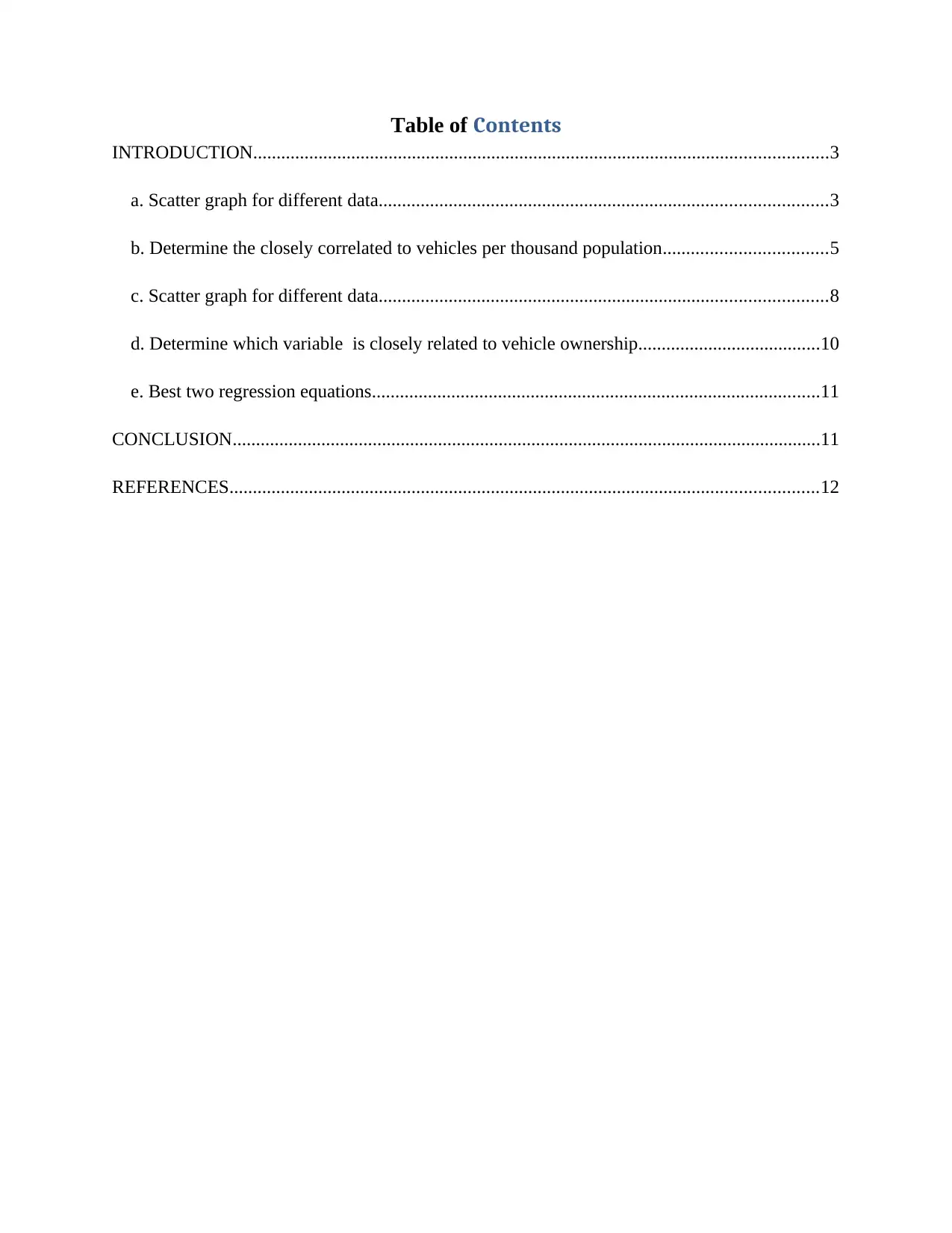
Table of Contents
INTRODUCTION...........................................................................................................................3
a. Scatter graph for different data................................................................................................3
b. Determine the closely correlated to vehicles per thousand population...................................5
c. Scatter graph for different data................................................................................................8
d. Determine which variable is closely related to vehicle ownership.......................................10
e. Best two regression equations................................................................................................11
CONCLUSION..............................................................................................................................11
REFERENCES..............................................................................................................................12
INTRODUCTION...........................................................................................................................3
a. Scatter graph for different data................................................................................................3
b. Determine the closely correlated to vehicles per thousand population...................................5
c. Scatter graph for different data................................................................................................8
d. Determine which variable is closely related to vehicle ownership.......................................10
e. Best two regression equations................................................................................................11
CONCLUSION..............................................................................................................................11
REFERENCES..............................................................................................................................12
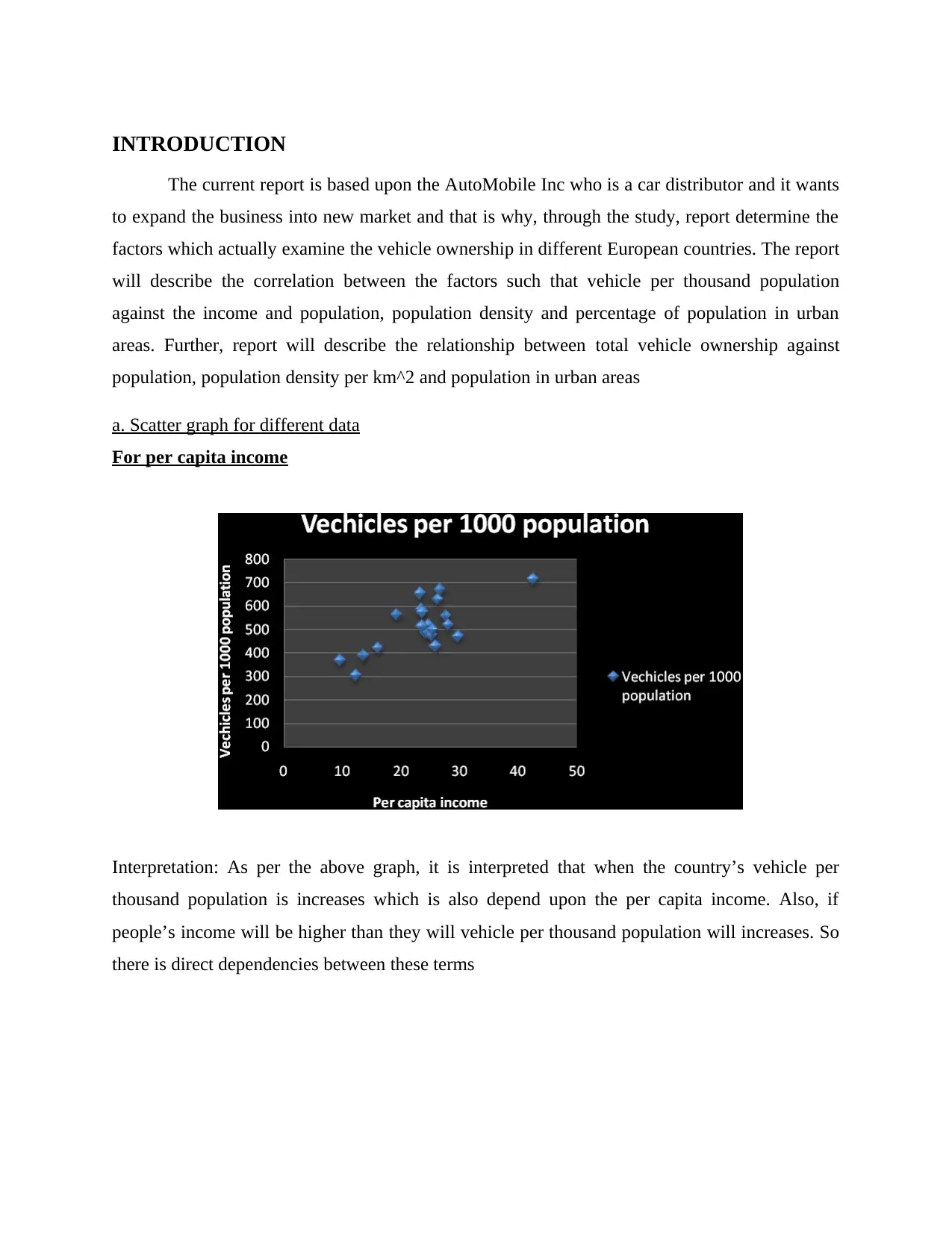
INTRODUCTION
The current report is based upon the AutoMobile Inc who is a car distributor and it wants
to expand the business into new market and that is why, through the study, report determine the
factors which actually examine the vehicle ownership in different European countries. The report
will describe the correlation between the factors such that vehicle per thousand population
against the income and population, population density and percentage of population in urban
areas. Further, report will describe the relationship between total vehicle ownership against
population, population density per km^2 and population in urban areas
a. Scatter graph for different data
For per capita income
Interpretation: As per the above graph, it is interpreted that when the country’s vehicle per
thousand population is increases which is also depend upon the per capita income. Also, if
people’s income will be higher than they will vehicle per thousand population will increases. So
there is direct dependencies between these terms
The current report is based upon the AutoMobile Inc who is a car distributor and it wants
to expand the business into new market and that is why, through the study, report determine the
factors which actually examine the vehicle ownership in different European countries. The report
will describe the correlation between the factors such that vehicle per thousand population
against the income and population, population density and percentage of population in urban
areas. Further, report will describe the relationship between total vehicle ownership against
population, population density per km^2 and population in urban areas
a. Scatter graph for different data
For per capita income
Interpretation: As per the above graph, it is interpreted that when the country’s vehicle per
thousand population is increases which is also depend upon the per capita income. Also, if
people’s income will be higher than they will vehicle per thousand population will increases. So
there is direct dependencies between these terms
⊘ This is a preview!⊘
Do you want full access?
Subscribe today to unlock all pages.

Trusted by 1+ million students worldwide
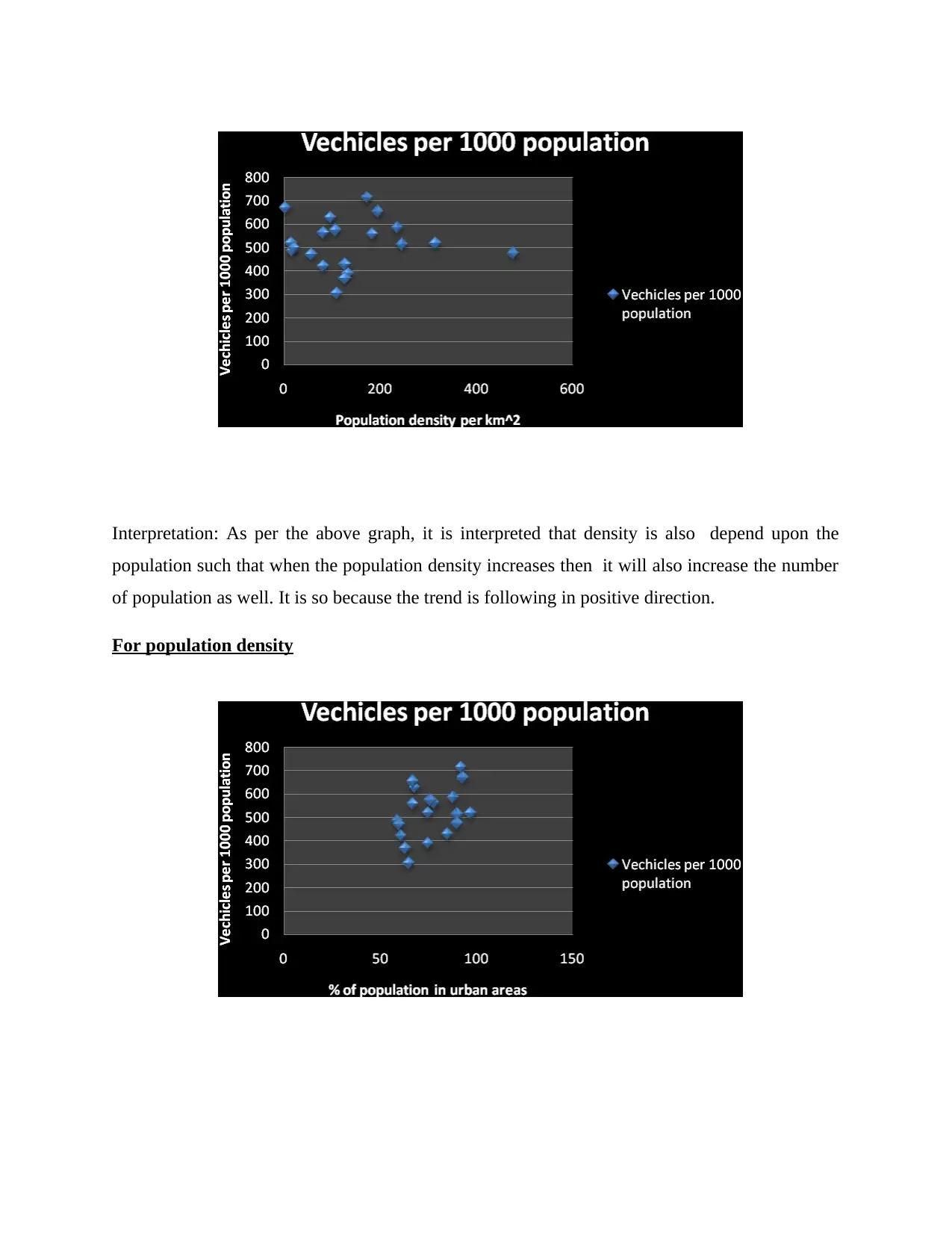
Interpretation: As per the above graph, it is interpreted that density is also depend upon the
population such that when the population density increases then it will also increase the number
of population as well. It is so because the trend is following in positive direction.
For population density
population such that when the population density increases then it will also increase the number
of population as well. It is so because the trend is following in positive direction.
For population density
Paraphrase This Document
Need a fresh take? Get an instant paraphrase of this document with our AI Paraphraser
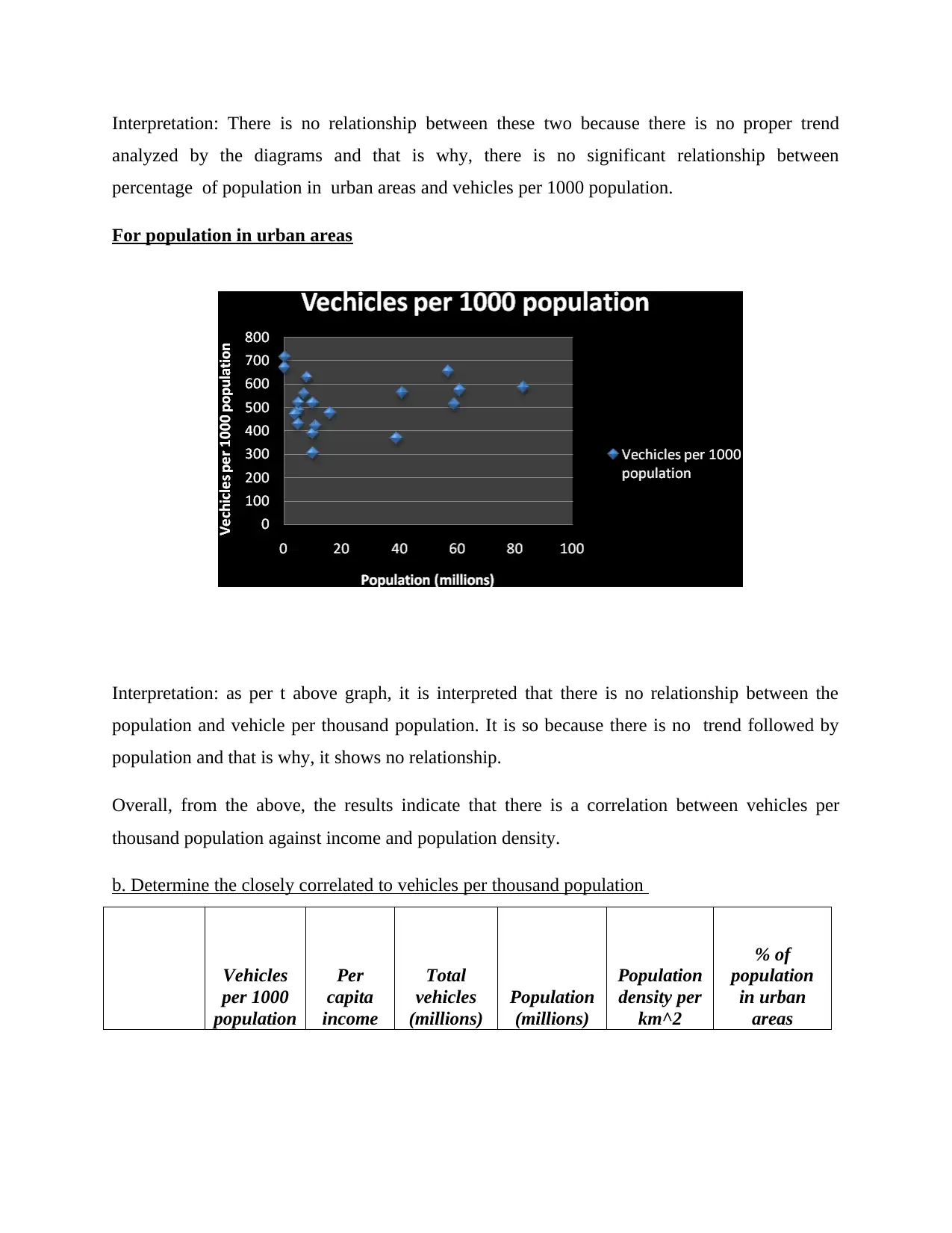
Interpretation: There is no relationship between these two because there is no proper trend
analyzed by the diagrams and that is why, there is no significant relationship between
percentage of population in urban areas and vehicles per 1000 population.
For population in urban areas
Interpretation: as per t above graph, it is interpreted that there is no relationship between the
population and vehicle per thousand population. It is so because there is no trend followed by
population and that is why, it shows no relationship.
Overall, from the above, the results indicate that there is a correlation between vehicles per
thousand population against income and population density.
b. Determine the closely correlated to vehicles per thousand population
Vehicles
per 1000
population
Per
capita
income
Total
vehicles
(millions)
Population
(millions)
Population
density per
km^2
% of
population
in urban
areas
analyzed by the diagrams and that is why, there is no significant relationship between
percentage of population in urban areas and vehicles per 1000 population.
For population in urban areas
Interpretation: as per t above graph, it is interpreted that there is no relationship between the
population and vehicle per thousand population. It is so because there is no trend followed by
population and that is why, it shows no relationship.
Overall, from the above, the results indicate that there is a correlation between vehicles per
thousand population against income and population density.
b. Determine the closely correlated to vehicles per thousand population
Vehicles
per 1000
population
Per
capita
income
Total
vehicles
(millions)
Population
(millions)
Population
density per
km^2
% of
population
in urban
areas
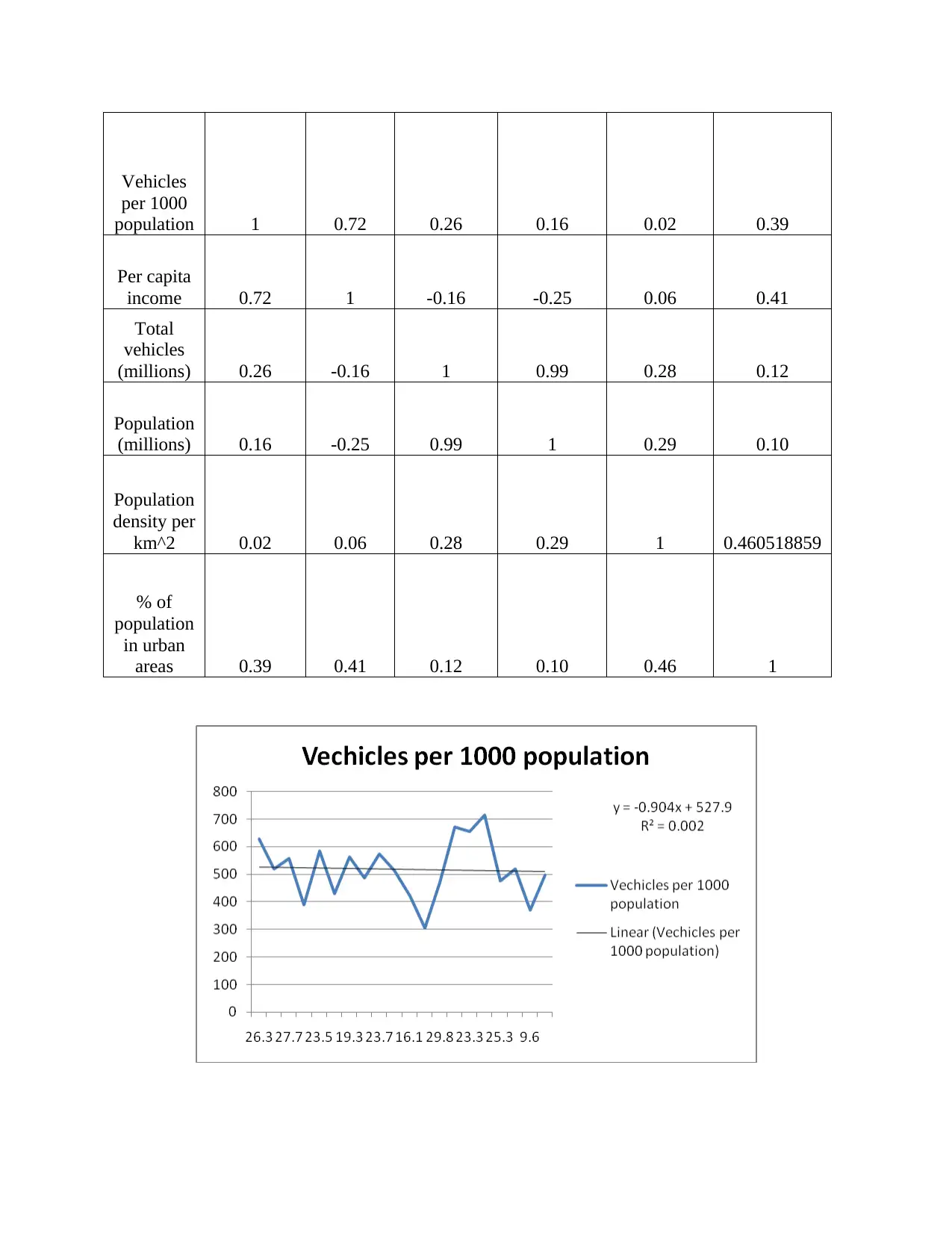
Vehicles
per 1000
population 1 0.72 0.26 0.16 0.02 0.39
Per capita
income 0.72 1 -0.16 -0.25 0.06 0.41
Total
vehicles
(millions) 0.26 -0.16 1 0.99 0.28 0.12
Population
(millions) 0.16 -0.25 0.99 1 0.29 0.10
Population
density per
km^2 0.02 0.06 0.28 0.29 1 0.460518859
% of
population
in urban
areas 0.39 0.41 0.12 0.10 0.46 1
per 1000
population 1 0.72 0.26 0.16 0.02 0.39
Per capita
income 0.72 1 -0.16 -0.25 0.06 0.41
Total
vehicles
(millions) 0.26 -0.16 1 0.99 0.28 0.12
Population
(millions) 0.16 -0.25 0.99 1 0.29 0.10
Population
density per
km^2 0.02 0.06 0.28 0.29 1 0.460518859
% of
population
in urban
areas 0.39 0.41 0.12 0.10 0.46 1
⊘ This is a preview!⊘
Do you want full access?
Subscribe today to unlock all pages.

Trusted by 1+ million students worldwide
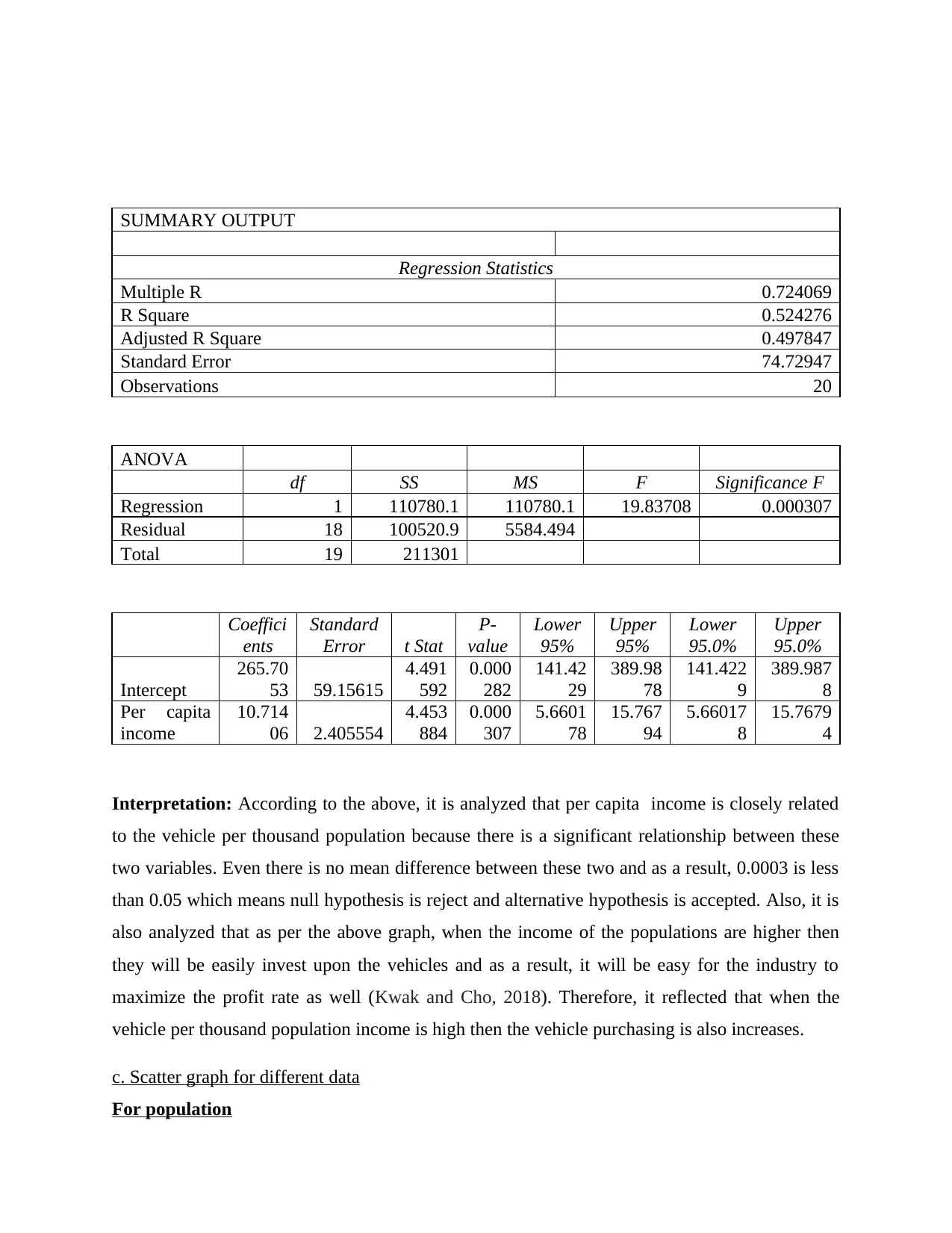
SUMMARY OUTPUT
Regression Statistics
Multiple R 0.724069
R Square 0.524276
Adjusted R Square 0.497847
Standard Error 74.72947
Observations 20
ANOVA
df SS MS F Significance F
Regression 1 110780.1 110780.1 19.83708 0.000307
Residual 18 100520.9 5584.494
Total 19 211301
Coeffici
ents
Standard
Error t Stat
P-
value
Lower
95%
Upper
95%
Lower
95.0%
Upper
95.0%
Intercept
265.70
53 59.15615
4.491
592
0.000
282
141.42
29
389.98
78
141.422
9
389.987
8
Per capita
income
10.714
06 2.405554
4.453
884
0.000
307
5.6601
78
15.767
94
5.66017
8
15.7679
4
Interpretation: According to the above, it is analyzed that per capita income is closely related
to the vehicle per thousand population because there is a significant relationship between these
two variables. Even there is no mean difference between these two and as a result, 0.0003 is less
than 0.05 which means null hypothesis is reject and alternative hypothesis is accepted. Also, it is
also analyzed that as per the above graph, when the income of the populations are higher then
they will be easily invest upon the vehicles and as a result, it will be easy for the industry to
maximize the profit rate as well (Kwak and Cho, 2018). Therefore, it reflected that when the
vehicle per thousand population income is high then the vehicle purchasing is also increases.
c. Scatter graph for different data
For population
Regression Statistics
Multiple R 0.724069
R Square 0.524276
Adjusted R Square 0.497847
Standard Error 74.72947
Observations 20
ANOVA
df SS MS F Significance F
Regression 1 110780.1 110780.1 19.83708 0.000307
Residual 18 100520.9 5584.494
Total 19 211301
Coeffici
ents
Standard
Error t Stat
P-
value
Lower
95%
Upper
95%
Lower
95.0%
Upper
95.0%
Intercept
265.70
53 59.15615
4.491
592
0.000
282
141.42
29
389.98
78
141.422
9
389.987
8
Per capita
income
10.714
06 2.405554
4.453
884
0.000
307
5.6601
78
15.767
94
5.66017
8
15.7679
4
Interpretation: According to the above, it is analyzed that per capita income is closely related
to the vehicle per thousand population because there is a significant relationship between these
two variables. Even there is no mean difference between these two and as a result, 0.0003 is less
than 0.05 which means null hypothesis is reject and alternative hypothesis is accepted. Also, it is
also analyzed that as per the above graph, when the income of the populations are higher then
they will be easily invest upon the vehicles and as a result, it will be easy for the industry to
maximize the profit rate as well (Kwak and Cho, 2018). Therefore, it reflected that when the
vehicle per thousand population income is high then the vehicle purchasing is also increases.
c. Scatter graph for different data
For population
Paraphrase This Document
Need a fresh take? Get an instant paraphrase of this document with our AI Paraphraser
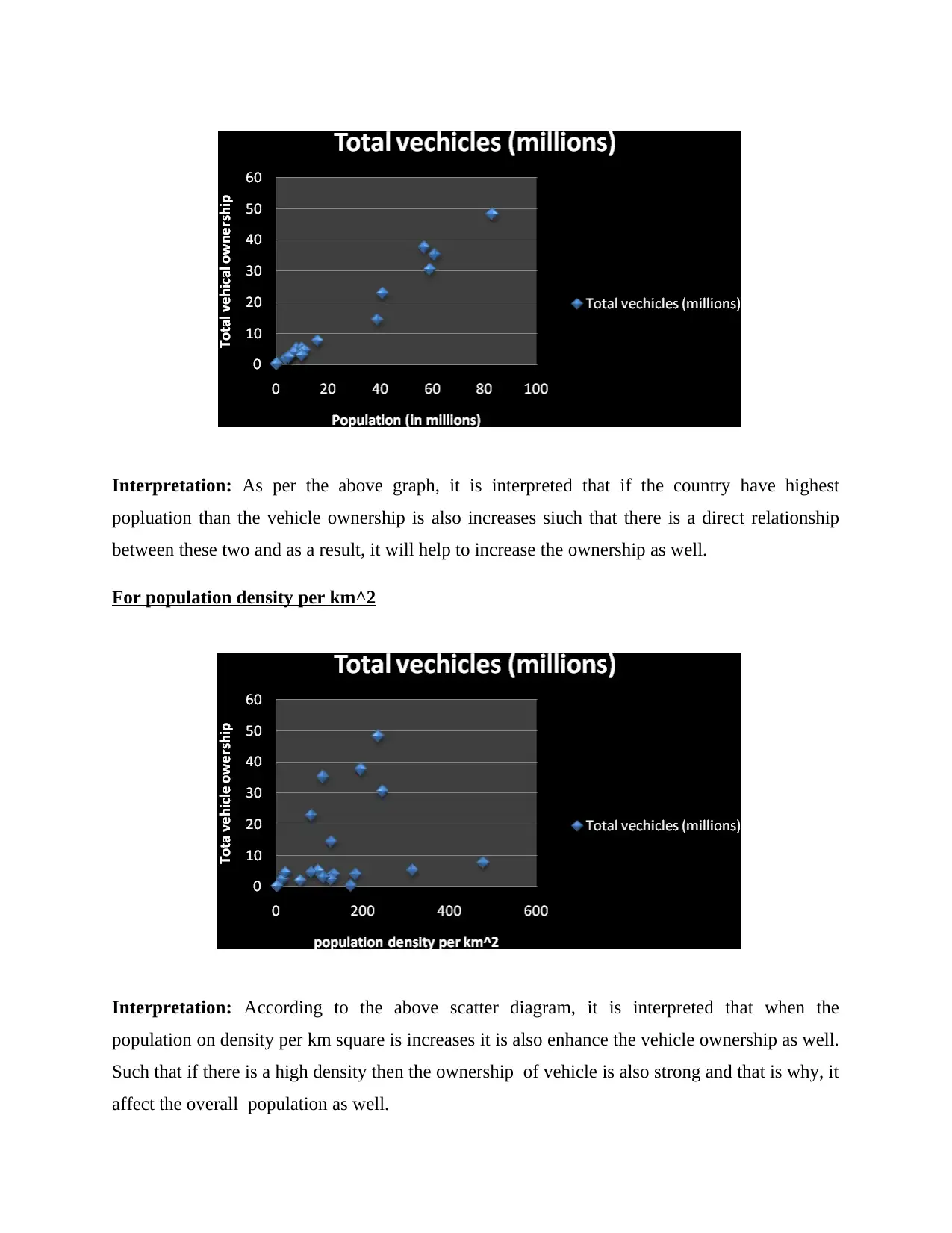
Interpretation: As per the above graph, it is interpreted that if the country have highest
popluation than the vehicle ownership is also increases siuch that there is a direct relationship
between these two and as a result, it will help to increase the ownership as well.
For population density per km^2
Interpretation: According to the above scatter diagram, it is interpreted that when the
population on density per km square is increases it is also enhance the vehicle ownership as well.
Such that if there is a high density then the ownership of vehicle is also strong and that is why, it
affect the overall population as well.
popluation than the vehicle ownership is also increases siuch that there is a direct relationship
between these two and as a result, it will help to increase the ownership as well.
For population density per km^2
Interpretation: According to the above scatter diagram, it is interpreted that when the
population on density per km square is increases it is also enhance the vehicle ownership as well.
Such that if there is a high density then the ownership of vehicle is also strong and that is why, it
affect the overall population as well.
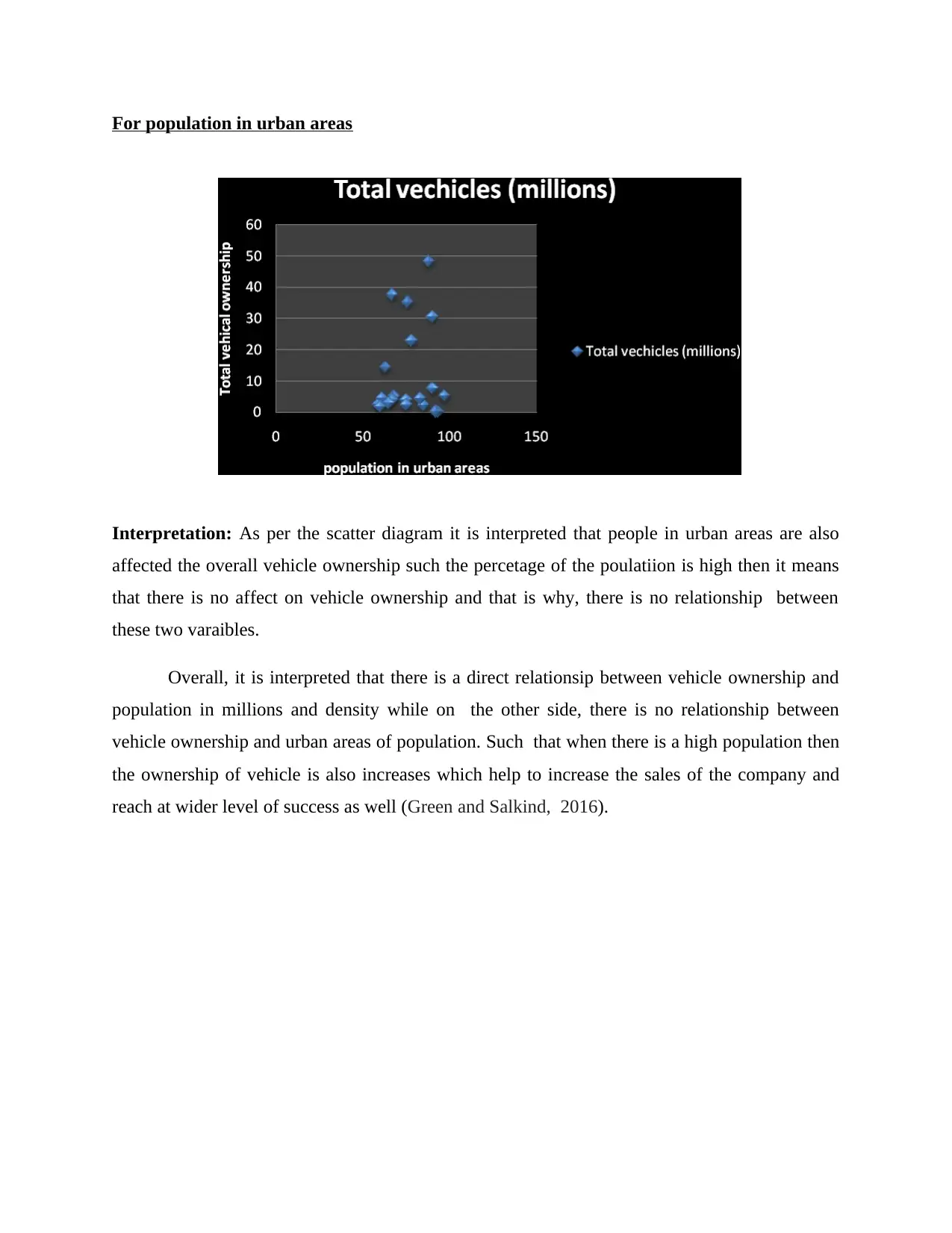
For population in urban areas
Interpretation: As per the scatter diagram it is interpreted that people in urban areas are also
affected the overall vehicle ownership such the percetage of the poulatiion is high then it means
that there is no affect on vehicle ownership and that is why, there is no relationship between
these two varaibles.
Overall, it is interpreted that there is a direct relationsip between vehicle ownership and
population in millions and density while on the other side, there is no relationship between
vehicle ownership and urban areas of population. Such that when there is a high population then
the ownership of vehicle is also increases which help to increase the sales of the company and
reach at wider level of success as well (Green and Salkind, 2016).
Interpretation: As per the scatter diagram it is interpreted that people in urban areas are also
affected the overall vehicle ownership such the percetage of the poulatiion is high then it means
that there is no affect on vehicle ownership and that is why, there is no relationship between
these two varaibles.
Overall, it is interpreted that there is a direct relationsip between vehicle ownership and
population in millions and density while on the other side, there is no relationship between
vehicle ownership and urban areas of population. Such that when there is a high population then
the ownership of vehicle is also increases which help to increase the sales of the company and
reach at wider level of success as well (Green and Salkind, 2016).
⊘ This is a preview!⊘
Do you want full access?
Subscribe today to unlock all pages.

Trusted by 1+ million students worldwide
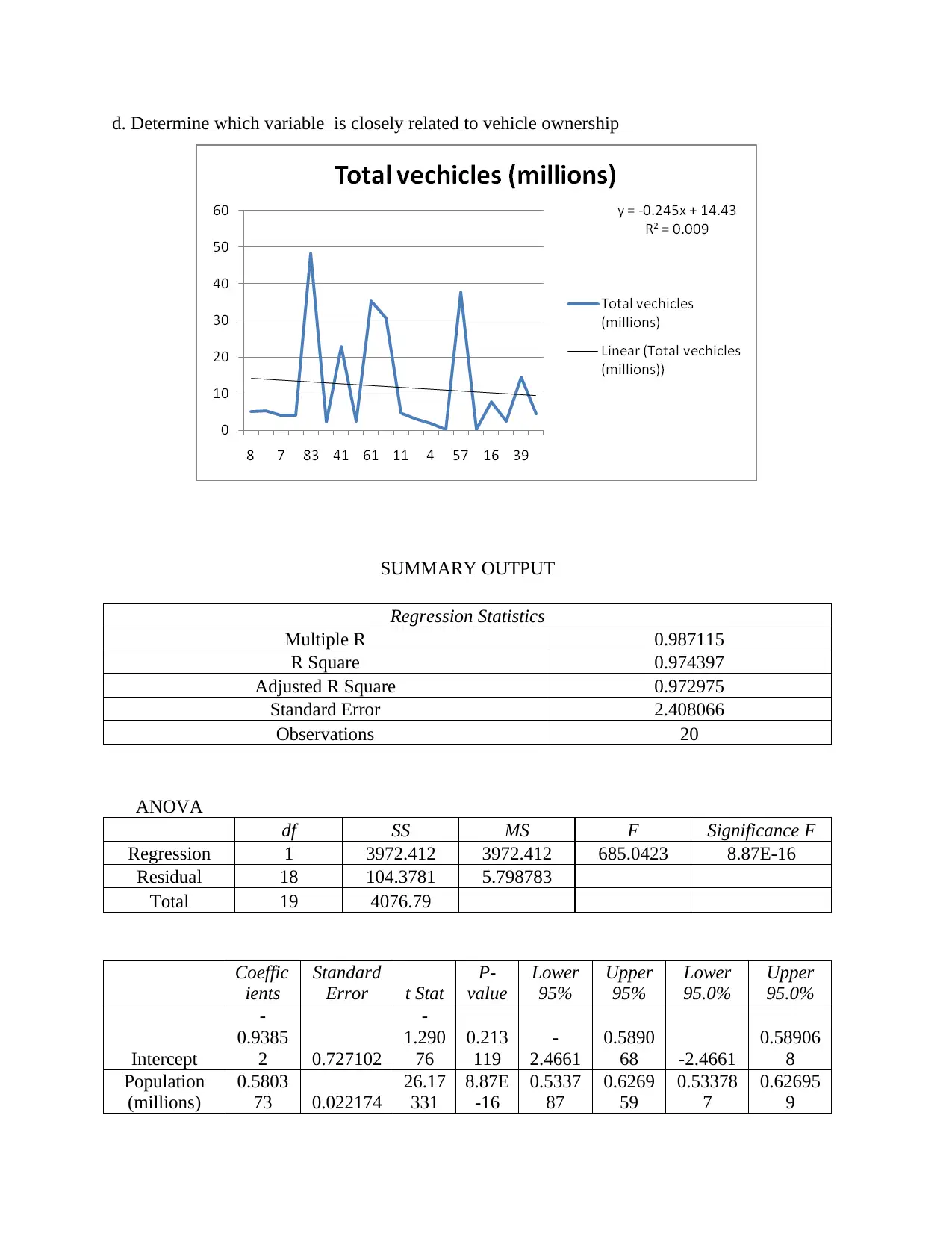
d. Determine which variable is closely related to vehicle ownership
SUMMARY OUTPUT
Regression Statistics
Multiple R 0.987115
R Square 0.974397
Adjusted R Square 0.972975
Standard Error 2.408066
Observations 20
ANOVA
df SS MS F Significance F
Regression 1 3972.412 3972.412 685.0423 8.87E-16
Residual 18 104.3781 5.798783
Total 19 4076.79
Coeffic
ients
Standard
Error t Stat
P-
value
Lower
95%
Upper
95%
Lower
95.0%
Upper
95.0%
Intercept
-
0.9385
2 0.727102
-
1.290
76
0.213
119
-
2.4661
0.5890
68 -2.4661
0.58906
8
Population
(millions)
0.5803
73 0.022174
26.17
331
8.87E
-16
0.5337
87
0.6269
59
0.53378
7
0.62695
9
SUMMARY OUTPUT
Regression Statistics
Multiple R 0.987115
R Square 0.974397
Adjusted R Square 0.972975
Standard Error 2.408066
Observations 20
ANOVA
df SS MS F Significance F
Regression 1 3972.412 3972.412 685.0423 8.87E-16
Residual 18 104.3781 5.798783
Total 19 4076.79
Coeffic
ients
Standard
Error t Stat
P-
value
Lower
95%
Upper
95%
Lower
95.0%
Upper
95.0%
Intercept
-
0.9385
2 0.727102
-
1.290
76
0.213
119
-
2.4661
0.5890
68 -2.4661
0.58906
8
Population
(millions)
0.5803
73 0.022174
26.17
331
8.87E
-16
0.5337
87
0.6269
59
0.53378
7
0.62695
9
Paraphrase This Document
Need a fresh take? Get an instant paraphrase of this document with our AI Paraphraser
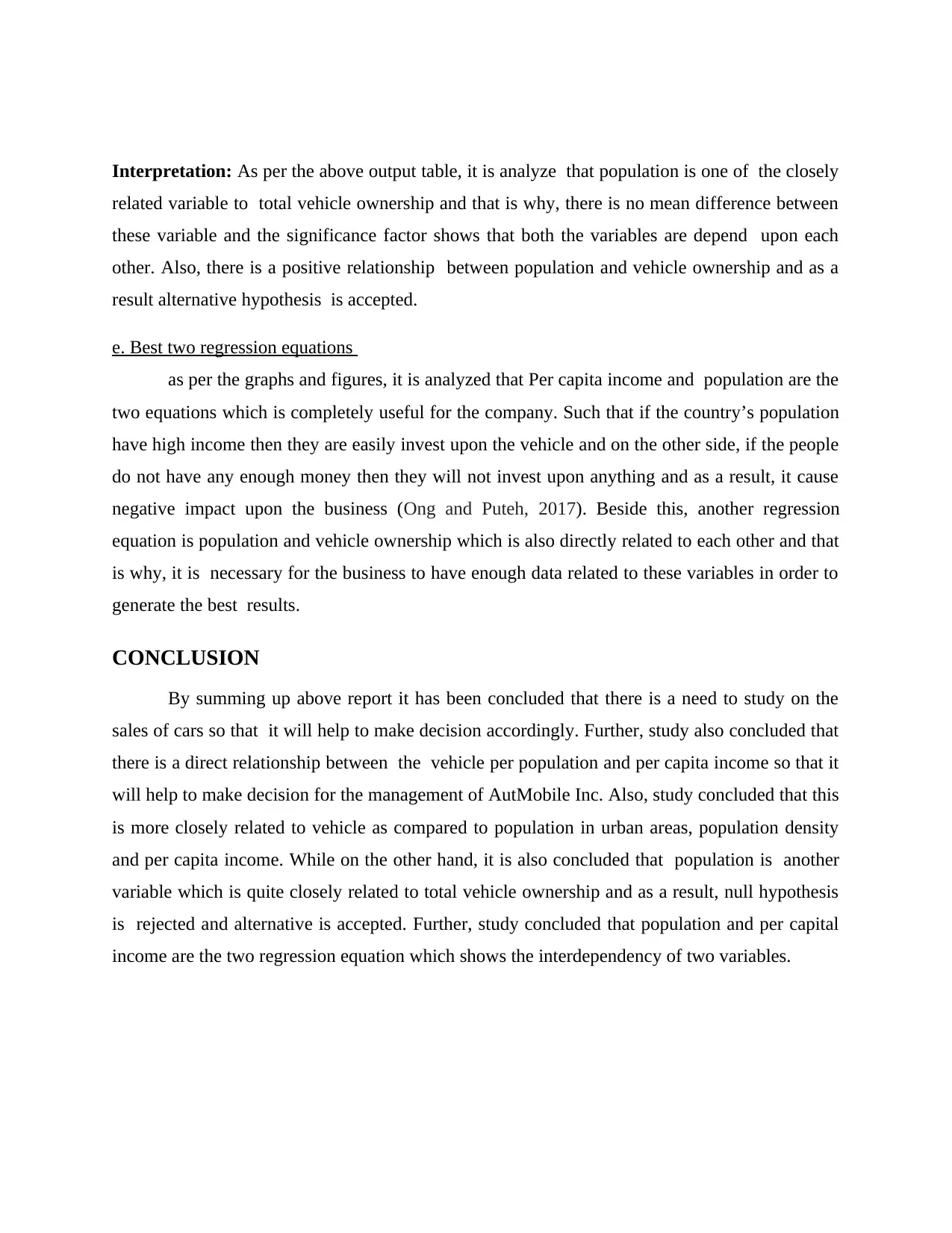
Interpretation: As per the above output table, it is analyze that population is one of the closely
related variable to total vehicle ownership and that is why, there is no mean difference between
these variable and the significance factor shows that both the variables are depend upon each
other. Also, there is a positive relationship between population and vehicle ownership and as a
result alternative hypothesis is accepted.
e. Best two regression equations
as per the graphs and figures, it is analyzed that Per capita income and population are the
two equations which is completely useful for the company. Such that if the country’s population
have high income then they are easily invest upon the vehicle and on the other side, if the people
do not have any enough money then they will not invest upon anything and as a result, it cause
negative impact upon the business (Ong and Puteh, 2017). Beside this, another regression
equation is population and vehicle ownership which is also directly related to each other and that
is why, it is necessary for the business to have enough data related to these variables in order to
generate the best results.
CONCLUSION
By summing up above report it has been concluded that there is a need to study on the
sales of cars so that it will help to make decision accordingly. Further, study also concluded that
there is a direct relationship between the vehicle per population and per capita income so that it
will help to make decision for the management of AutMobile Inc. Also, study concluded that this
is more closely related to vehicle as compared to population in urban areas, population density
and per capita income. While on the other hand, it is also concluded that population is another
variable which is quite closely related to total vehicle ownership and as a result, null hypothesis
is rejected and alternative is accepted. Further, study concluded that population and per capital
income are the two regression equation which shows the interdependency of two variables.
related variable to total vehicle ownership and that is why, there is no mean difference between
these variable and the significance factor shows that both the variables are depend upon each
other. Also, there is a positive relationship between population and vehicle ownership and as a
result alternative hypothesis is accepted.
e. Best two regression equations
as per the graphs and figures, it is analyzed that Per capita income and population are the
two equations which is completely useful for the company. Such that if the country’s population
have high income then they are easily invest upon the vehicle and on the other side, if the people
do not have any enough money then they will not invest upon anything and as a result, it cause
negative impact upon the business (Ong and Puteh, 2017). Beside this, another regression
equation is population and vehicle ownership which is also directly related to each other and that
is why, it is necessary for the business to have enough data related to these variables in order to
generate the best results.
CONCLUSION
By summing up above report it has been concluded that there is a need to study on the
sales of cars so that it will help to make decision accordingly. Further, study also concluded that
there is a direct relationship between the vehicle per population and per capita income so that it
will help to make decision for the management of AutMobile Inc. Also, study concluded that this
is more closely related to vehicle as compared to population in urban areas, population density
and per capita income. While on the other hand, it is also concluded that population is another
variable which is quite closely related to total vehicle ownership and as a result, null hypothesis
is rejected and alternative is accepted. Further, study concluded that population and per capital
income are the two regression equation which shows the interdependency of two variables.
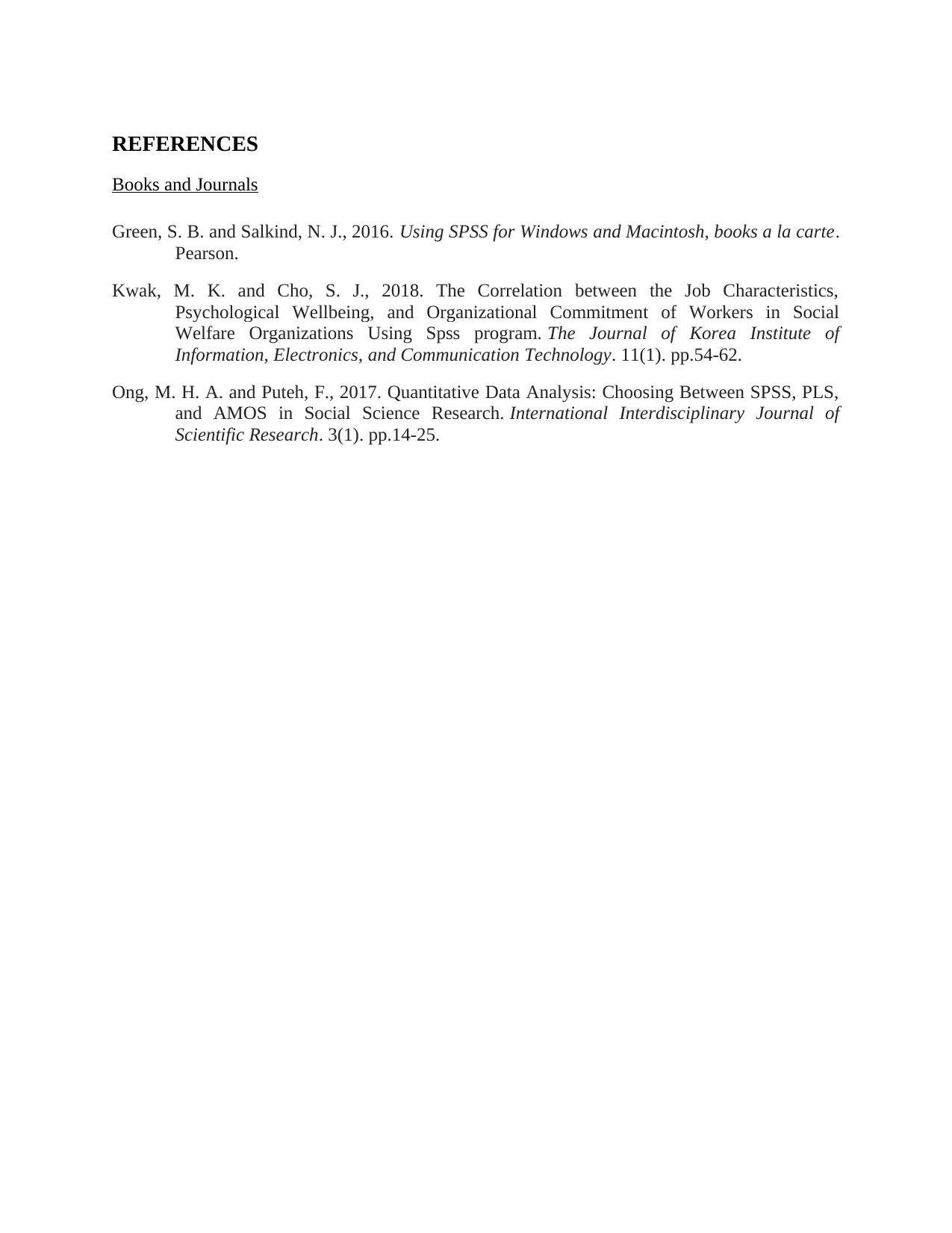
REFERENCES
Books and Journals
Green, S. B. and Salkind, N. J., 2016. Using SPSS for Windows and Macintosh, books a la carte.
Pearson.
Kwak, M. K. and Cho, S. J., 2018. The Correlation between the Job Characteristics,
Psychological Wellbeing, and Organizational Commitment of Workers in Social
Welfare Organizations Using Spss program. The Journal of Korea Institute of
Information, Electronics, and Communication Technology. 11(1). pp.54-62.
Ong, M. H. A. and Puteh, F., 2017. Quantitative Data Analysis: Choosing Between SPSS, PLS,
and AMOS in Social Science Research. International Interdisciplinary Journal of
Scientific Research. 3(1). pp.14-25.
Books and Journals
Green, S. B. and Salkind, N. J., 2016. Using SPSS for Windows and Macintosh, books a la carte.
Pearson.
Kwak, M. K. and Cho, S. J., 2018. The Correlation between the Job Characteristics,
Psychological Wellbeing, and Organizational Commitment of Workers in Social
Welfare Organizations Using Spss program. The Journal of Korea Institute of
Information, Electronics, and Communication Technology. 11(1). pp.54-62.
Ong, M. H. A. and Puteh, F., 2017. Quantitative Data Analysis: Choosing Between SPSS, PLS,
and AMOS in Social Science Research. International Interdisciplinary Journal of
Scientific Research. 3(1). pp.14-25.
⊘ This is a preview!⊘
Do you want full access?
Subscribe today to unlock all pages.

Trusted by 1+ million students worldwide
1 out of 12
Related Documents
Your All-in-One AI-Powered Toolkit for Academic Success.
+13062052269
info@desklib.com
Available 24*7 on WhatsApp / Email
![[object Object]](/_next/static/media/star-bottom.7253800d.svg)
Unlock your academic potential
Copyright © 2020–2025 A2Z Services. All Rights Reserved. Developed and managed by ZUCOL.




